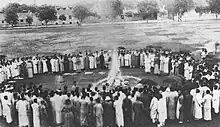Boycotts of Japanese products have been conducted by numerous Korean, Chinese and American civilian and governmental organizations in response to real or disputed Japanese aggression and atrocities, whether military, political or economic.
20th century

The first boycott of Japanese products in China was started 1915 as a result of public indignation at the Twenty-One Demands which Japan forced China to accept. In 1919, the students and intellectuals involved in the May Fourth Movement called for another boycott of Japanese products, to which the public responded enthusiastically. Local chambers of commerce decided to sever economic ties with Japan, workers refused to work in Japanese-funded factories, consumers refused to buy Japanese goods, and students mobilised to punish those found selling, buying or using Japanese products.
The Jinan Incident of 1928 prompted a new boycott. This time, the Kuomintang government mobilised the Chinese population to cease economic dealings with Japan. From then on, anti-Japanese protests in China would always be accompanied with boycotts of Japanese products.
The Japanese invasion of China in 1931 and the conquest of Manchuria were roundly criticized in the United States. In addition, efforts by citizens outraged at Japanese atrocities, such as the Nanking Massacre, led to calls for American economic intervention to encourage Japan to leave China; these calls played a role in shaping American foreign policy. As more and more unfavorable reports of Japanese actions came to the attention of the American government, embargoes on oil and other supplies were placed on Japan, out of concern for the Chinese populace and for American interests in the Pacific. The American public became increasingly pro-Chinese and anti-Japanese, an example being a grassroots campaign for women to stop buying silk stockings because the material was procured from Japan through its colonies.[1]
After World War II, the Chinese community, which was upset over various issues such as the sovereignty of Senkaku Islands, the Japanese history textbook controversies and Japanese leaders' visits to Yasukuni Shrine, would launch boycotts of Japanese products. Republic of China citizens started a boycott in September 1972 to protest Japan's diplomatic recognition of the People's Republic of China and twice burned Japanese products in front of the Taipei City Hall, which was coincidentally of Japanese construction.
21st century

In 2005, a new wave of boycotts were started in mainland China, concurrent with the anti-Japanese demonstrations in major Chinese cities at the time. However, this boycott was at best a fringe attempt, and was denounced by the mainstream population, citing that China was integrated into the world economy and a boycott of one of China's biggest trading partners would cause as much harm to China as it would to Japan. Most people were more concerned over their standards of living than redressing old grievances. The Chinese Ministry of Foreign Relations gave a similar view: That "Sino-Japanese economic cooperation developed significantly over the past decade and brought real benefits to the people of both nations. We do not wish for economic issues to be politicised." As with the anti-Japanese demonstrations, these activists began organising boycotts using the internet and mobile phones.
Boycott in South Korea
In 2019, a new wave of boycotts were started in South Korea as a response to the 2019–2020 Japan–South Korea trade dispute. People participating in the movement started not buying Japanese products and services, travelling to Japan, and not watching Japanese-made films.[2][3]
In March, 2019, Gyeonggi Province proposed an ordinance that would require schools to place a sticker on products made by some 284 Japanese companies (such as Nikon, Panasonic, and Yamaha which produce projectors and musical instruments for schools) that says "this product is made by a Japanese war criminal company".[4][5] Of 27 members who put forward the bill, 25 belonged to the Democratic Party of Korea.[6] It was argued by proponents that the bill was not a boycott, but that it was to give students a correct understanding of history. In Sept 2019, Busan and Seoul Metropolitan Council successfully passed a non-binding ordinances to label products from the same list of companies. In Seoul, this would apply to new products, while the Busan law applies to products that were already purchased.[7]
See also
References
- ↑ Glickman 2009, p. 225, 227.
- ↑ "South Koreans call for boycott of Japanese cars, beer and cosmetics as 'trade war' intensifies". South China Morning Post. July 4, 2019. Retrieved July 28, 2019.
- ↑ "South Koreans are cancelling their Japan trip amid trade war". Travel Daily Media. July 23, 2019.
- ↑ "South Korea region seeks to tag Japanese firms as 'war criminals'". Nikkei Asia. Retrieved October 14, 2022.
- ↑ Kang, Tae-jun. "One South Korean Province Wants to Tag Japanese Firms as 'War Criminals'". thediplomat.com. Retrieved October 14, 2022.
- ↑ Herald, Korea (March 21, 2019). "[Editorial] Outmoded nationalism". The Korea Herald. Retrieved October 14, 2022.
- ↑ NEWS, KYODO. "S. Korea's 2 major cities pass bill to boycott "war crime" firms". Kyodo News+. Retrieved October 14, 2022.
Sources
- Glickman, Lawrence B. (2009). Buying Power: A History of Consumer Activism in America. Chicago: University of Chicago Press. ISBN 9780226298672 – via Internet Archive.